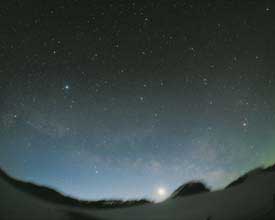
The grand sweep of the summer Milky Way hugs the southeastern horizon in this wide-field photograph by Akira Fujii. The Great Rift, seen here as a line of dark patches bisecting the star fields of our galaxy, spans more than a third of the sky. Venus is rising at lower center. Click on the image for a better view of the Great Rift.
Dark nebulae can be enjoyed with the unaided eye, or with binoculars and rich-field telescopes (RFTs), or with the largest amateur instruments. Sometimes called absorption nebulae, they range from small black voids a few arcminutes across to the Great Rift stretching more than 120° from Deneb to Alpha Centauri.
After the Great Rift, what's the easiest naked-eye dark nebula for Northern Hemisphere observers? I'd say it's the large wedge near the Cepheus-Cygnus border. It descends south from a wide, dark mass to a tapered tip 10° east of Deneb. Curiously, this prominent and widely known black cloud is unnamed. I call it the Funnel Cloud nebula.
Both the Great Rift and the Funnel Cloud are visible even when a nine-day-old Moon is in the sky — if the atmosphere is clean enough that the scattering of moonlight is minimal and no other light pollution is present.
The Coalsacks
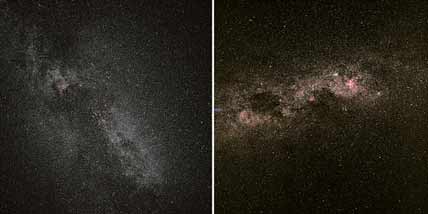
The Northern Coalsack (left) lies next to Deneb in Cygnus, the Swan. From antipodean climes, the southern Coalsack (right) is visible as a very dark region bordering the Southern Cross. Both images are about 35° square.
Courtesy Dennis di Cicco.
At the bulbous northern end of the Great Rift, between Alpha and Gamma Cygni, is the Northern Coalsack. Since it adjoins the Northern Cross asterism, the derivation of the name is obvious; the original Coalsack is near the Southern Cross (and is invisible at midnorthern latitudes). This is perhaps the only object in the sky's northern hemisphere named after one in the south.
Few dark nebulae are as prominent as the Coalsacks, however. Most are subtle contrast features winding through the richest starclouds. Even though my subdivision long ago voted against installing the scourge of streetlights, and though I often enjoy 6th-magnitude skies from my backyard, I still drive to nearby mountain wilderness to observe dark nebulae.
For instance, how many amateurs know that a straight, 6° black belt is sometimes visible to the naked eye running from 1° west of Gamma Cygni to 1° east of Eta Cygni? Or that, if the sky is dark enough, you can spot long, serpentine forms in the Milky Way just poleward of Cassiopeia's W?
The Pipe and the Princing Horse
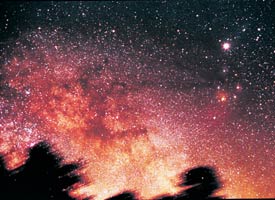
Deep-sky objects abound in this wide-angle view of Ophiuchus. In the center is the Pipe Nebula, which forms the rear half of the Prancing Horse Nebula. When conditions are excellent, these and other dark nebulae are apparent without optical aid. Jupiter is seen at upper right. Click on the image for a better view of the Prancing Horse Nebula.
Courtesy Vince and Maggie Farnsworth.
The 7°-long Pipe Nebula is a fine naked-eye object in southern Ophiuchus. Start your search about 12° east of Antares for a line of three 3rd- and 4th-magnitude stars, the only reasonably prominent stars in that area. The brightest, Theta Ophiuchi, lies at the line's midpoint. Barnard 78, the bowl of the Pipe Nebula, is centered 3° east-southeast of Theta. The pipe's stem passes 2° south of Theta and ends 3½° to the star's southwest, just past the southernmost star in the line, 36 Ophiuchi. In superb skies my 7x50 binoculars can distinguish each of the connected dark clouds that the unaided eye strings together as the Pipe's stem. West to east, these dust clouds are cataloged as B59, B65, B66, and B67.
My first view of the Pipe Nebula was at the 1983 Texas Star Party. A decade later Jim Failes surprised me by pointing out the Pipe's naked-eye visibility at the Mount Kobau Star Party in British Columbia, fully 19° of latitude farther north. If your skies don't match those of Prude Ranch or Kobau, try binoculars. They'll reveal the Pipe's distinctive shape in merely decent skies.
The markedly oblate globular cluster M19 serves as a useful landmark for those using RFTs. The Pipe's stem begins only 2° west-southwest of this 7th-magnitude cluster.
The Prancing Horse Nebula
The Pipe Nebula also forms the rear legs and hindquarters of the huge Prancing Horse Nebula, which can be found midway between M24 and Antares. The entire Prancing Horse is clearly visible without optical aid from Mount Kobau's summit.
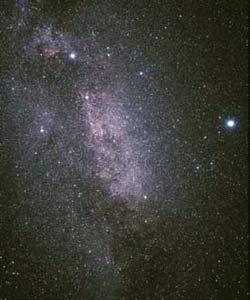
Thousands of stars crowd this image of the Northern Cross. Deneb is the bright star to the upper left; Vega is to the right. Alan Whitman calls the dark nebula east (left) of Deneb the Funnel Cloud.
Courtesy Akira Fujii.
In the summer of 1997 I was pleasantly surprised to see the Prancing Horse with my unaided eyes at the Astro Atlantik star party in Fundy National Park on Canada's Atlantic coast. Almost all tales of memorable deep-sky observing start with a trek to a mountaintop. Yet Astro Atlantik lies within a few miles of the Bay of Fundy at an altitude of about 300 meters! A view of the night sky there emphasizes how much has been lost in more densely populated areas of the continent. I observed at Fundy as a youth, and my logbooks describe great skies, the first dark skies that I had experienced. After decades in the west I wondered if my boyhood skies were really as fine as I remembered them to be. They are!
Holes in the Heavens
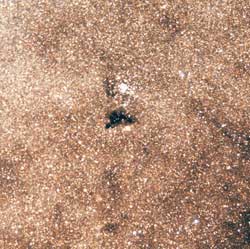
B86 is one of the most striking dark nebulae in the sky for a telescope, set as it is against particularly rich star fields in Sagittarius. Edward E. Barnard himself described the object as a 'remarkable small inky black hole in a crowded part of the Milky Way.'
Courtesy Luke Dodd.
On photographs, the Snake or S Nebula looks like a tiny wisp of smoke rising from the bowl of the Pipe Nebula. Barnard 72 coils across a Moon's diameter of sky 1.5° north-northeast of Theta Ophiuchi. It's challenging in my 16-inch f/4.5 reflector at low power, but in the 1998 RASC Observer's Handbook, Alan Dyer and Alister Ling suggest that a 3- to 5-inch RFT may reveal it. The western loop of the S is ill defined near the loop's center both visually and photographically.
William Herschel's Hole in the Heavens near Rho Ophiuchi is a nearly starless area stretching for field after field at 120x in the 24-inch Cassegrain of the Prince George Observatory in central British Columbia. According to Burnham's Celestial Handbook, Herschel had the whimsical idea that the nearby globular cluster M80 might have formed from the "missing" stars.
Black and roughly triangular, little Barnard 86 (4.5' by 3') stands out dramatically in the Sagittarius starcloud through any telescope from a 4-inch RFT on up. The adjacent open cluster NGC 6520 heightens the contrast between darkness and light. Located 2.7° north-northwest of Gamma Sagittarii, B86 culminates only 13° above the Mount Kobau horizon, so I hadn't looked for this inkblot until John Dobson showed me 12 years ago that it could be seen from so far north. This first view of the dark mass — between an open cluster on one side and a red star on the other — with Dobson's magnificent 18-inch mirror is still the best that I have ever enjoyed.
RFTs or binoculars reveal sinuous dusky ribbons in many Milky Way fields. Spend some time slowly sweeping the Sagittarius starcloud and the Scorpius Milky Way. You will find them marbled with faint contrast features on the most memorable nights.
Dark Rifts
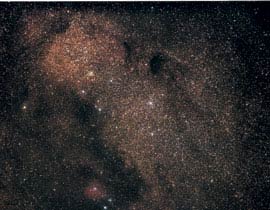
The conspicuous dark nebula B92 (upper center) in Sagittarius was influential in convincing Barnard that such objects were dark clouds, not holes in the starry sky. B93 is the smaller region just east of B92 in this 2¾°-wide field.
Courtesy Luke Dodd.
M24, the Small Sagittarius Starcloud, harbors twin dust clouds, Barnard 92 and 93, visible in 7x50 binoculars. The two perch near the northern edge of M24, where they are very dramatic in my 8-inch f/6 Newtonian at low power. In such a telescope, the lone 12th-magnitude star in B92 is an islet in a black lake outlined by the rich star swarms of M24. B92 is 15' by 10'. In superb skies both my 8-inch and my 4-inch Astroscan can trace dark streams commencing at the western shore of B92. The longest stream can be followed 1° to the southwest edge of M24. Narrower B93 lies about 1/3° east of B92.
Occasionally I can see hints of the amorphous dark structures that photographs show between B93 and the eastern margin of the starcloud. All amateurs have favorite objects that they enjoy introducing to others. Many times I've enjoyed listening to neophytes' reactions when they're shown B92 and B93 for the first time.
Some of the best dark nebulae for 4- to 8-inch telescopes are found near the glorious open cluster M11 in the Scutum starcloud. The Barnard 114-118 complex begins ½° southeast of M11. From there it runs southward about 1°. Sweeping the cluster's vicinity will reveal other contrast features. Coal-black, 1°-wide Barnard 103 is 3° west of M11 midway between Alpha and Beta Scuti, at the edge of the Great Rift.
Two of the easiest dark nebulae are B142 and B143, about 1½° west-northwest of Gamma Aquilae. They outline most of a 1°-high capital E, shown readily by 7x50 binoculars even in suburban skies. Burnham's Celestial Handbook says: "Appearing not merely as a starless area, it actually gives a strong impression of an obscuring mass suspended between the observer and the star-strewn background."
Here is a list of some selected Barnard Objects that observers will find interesting. Many are mentioned in this article.
| Barnard Objects | |||
| Barnard Number | R.A. | Decl. | Dimensions |
| B59, 65, 66, 67 | 17h 21m | -27° | 7° long |
| N72 | 17h 23m | -24° | 30' |
| B86 | 18h 03m | -27° | 4.5' x 3' |
| B88 | 18h 04m | -24° | ? |
| B92 | 18h 15m | -18° | 15' x 10' |
| B93 | 18h 17m | -18° | 12' x 2' |
| B103 | 18h 39m | - 7° | 60' |
| B114-118 | 18h 53m | - 7° | 50' x 5' |
| B142, 143 | 19h 41m | 11° | 80' x 50' |
| B168 | 21h 53m | 47° | 100' x 10' |
| B352 | 20h 57m | 45° | 20' x 10' |
| B361 | 21h 13m | 47° | 30' |
The Trifid and the Cocoon
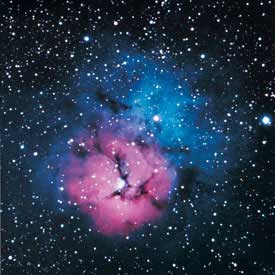
One of the best-known deep-sky objects in Sagittarius is the combination reflection and emission nebula M20, the Trifid. The dark dust lanes are well shown in this image.
Courtesy Jason Ware.
The celebrated dark lanes of M20, the Trifid Nebula, are well seen in an 8-inch Newtonian at moderate power. Some report detecting them with a good 3-inch. C. E. Barns, in his 1929 book 1,001 Celestial Wonders, captured the essence of the Trifid: "a dark night revelation, even in modest apertures . . . bulbous image trisected with dark rifts of interposing opaque cosmic dust-clouds. . . ." However, both my eyepiece and photographs show four dark lanes, not three.
A dense dust cloud shapes the neck of the Swan Nebula, M17. This cloud looks distinctly darker than any other place in the field of view. Several narrow gray ribbons cross the Swan's body and lower neck diagonally. One superb night my 8-inch showed these features at 174x, before nebula filters were available. A 16-inch shows them routinely. John Casino's 36-inch Dobsonian with an O III filter revealed the linear absorption nebulae in M17 just as clearly as a photograph.
Under wilderness skies the 4-inch Astroscan at 16x with a UHC filter will find the triangular dark intrusion opposite the Star Queen in M16. But the Star Queen herself — a figure of dark nebulae made famous by the green and brown Hubble Space Telescope image of her head and upraised arms — required Bryce Heartwell's 10-inch reflector and a UHC filter on an excellent night. The Star Queen can be seen without a nebula filter in my 16-inch at 65x.
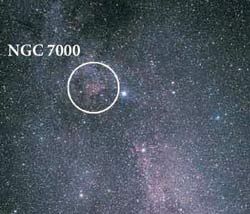
NGC 7000, the North America Nebula, lies just to the east of the bright star Deneb in Cygnus, the Swan.
Courtesy Akira Fujii.
Farther north, dust clouds sculpt the North America Nebula. We see them in binoculars or RFTs as the Atlantic Ocean, Gulf of Mexico, and Pacific Ocean. My Astroscan also indicates an intrusion where Hudson Bay would be, but Barnard 352 is too narrow to properly represent that great sea.
Alan M. MacRobert saw Barnard 361 in Cygnus through suburban light pollution. Using his 6-inch reflector at 45x, MacRobert called it "a well-defined and eerie dark nebula just south-southeast of [open cluster] IC 1369 . . . a big, dark hole in the Milky Way, its edges limned by rich starfields." From the round 30'-diameter main mass, my 8-inch reveals a narrow tail running immediately west of the pair of prominent stars ¼° west of the open cluster. B361 is beside the Funnel Cloud, 1° east-southeast of 63 Cygni.
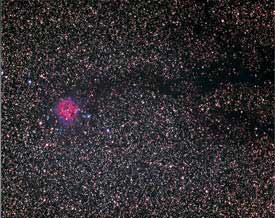
The Cocoon Nebula (IC 5746) nestles in a sparse star cluster at the end of a long tunnel of dark nebulosity, Barnard 168, in Cygnus. While the Cocoon is detectable with a small telescope, larger apertures are needed for B168.
Courtesy George Greaney.
Another quarry in Cygnus is the 2°-long Barnard 168, which meanders to and engulfs the Cocoon Nebula (IC 5146) at its eastern end. Through my 16-inch Dobsonian, B168 is more prominent than the faint 12' by 10' Cocoon. Dyer and Ling say that a hydrogen-beta filter may reveal the Cocoon with an 8- to 10-inch telescope.
Under black skies, the Astroscan at 16x shows very intricate structures around Gamma Cygni. Several dark bands can be followed between patches of emission nebulae within the Cygnus starcloud. Even 7x50 binoculars find dark windings around Gamma.
When the luminous starclouds of Sagittarius and Scutum cast shadows, when M7 and M8 stand out as bright naked-eye cloudlets, then you are enjoying the pristine skies that will make our mottled galaxy's more challenging dust clouds remarkably visible in silhouette.
 0
0
Comments
You must be logged in to post a comment.